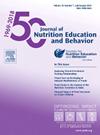粮食不安全,营养安全,感知有限可得性和利用障碍之间的关系
IF 2.3
3区 医学
Q2 EDUCATION, SCIENTIFIC DISCIPLINES
引用次数: 0
摘要
背景:营养安全、可获得性有限和利用障碍被认为是与粮食不安全有关的新措施,但它们之间的相互关系尚未确定。目的评估联邦合格医疗中心(FQHC)患者样本中食品不安全、营养安全、感知有限可用性和利用障碍之间的相互关系。研究设计、环境、参与者:100名糖尿病前期或糖尿病患者从德克萨斯州的一个安全网诊所接受治疗,被招募到一个试点产品处方项目中。参与者可以获得390美元,通过补贴的流动市场和送货上门计划购买当地农产品。参与者完成了关于粮食不安全、营养安全、可获得性有限和利用障碍的调查。可测量的结果/分析根据营养与健康影响中心指南,对营养安全性、可感知的有限可用性和利用障碍(分别为4项、3项和8项)进行了测量和分类。使用美国农业部美国家庭食品安全调查模块六项简短表格评估食品不安全状况,如果参与者肯定地回答了一个或多个问题,则将其归类为食品不安全。Spearman相关用于评估测量之间关系的方向和强度。结果51名参与者(52.5(±9.1)岁,71%为女性,57%为西班牙裔)具有完整的所有测量数据。12个国家(26%)营养不安全,13个国家(28%)认为供应有限,12个国家(26%)报告利用障碍高,29个国家(62%)粮食不安全。营养不安全与粮食不安全呈弱相关(p=。33, P=.02)和感知到的有限可用性(P=。31, P=.02),与利用障碍中度相关(P=。56、P <;措施)。粮食不安全与利用障碍中度相关(p=。43, P=.002),但不认为有限的可用性(P=.002)。27日,P = 0。06)。感知到的有限可用性和利用障碍有中等相关性(p=。42岁的P = .002)。结论:这项研究表明,食物环境测量之间存在显著但弱到中等的相关性,这表明可能需要所有四种测量方法。资助美国农业部格斯·舒马赫营养激励计划本文章由计算机程序翻译,如有差异,请以英文原文为准。
The Relationship Between Food Insecurity, Nutrition Security, Perceived Limited Availability, and Utilization Barriers
Background
Nutrition security, perceived limited availability, and utilization barriers are new measures believed to be related to food insecurity, but how they are correlated with one another has not been determined.
Objective
Assess how food insecurity, nutrition security, perceived limited availability, and utilization barriers are related to one another among a sample of federally qualified health center (FQHC) patients.
Study Design, Settings, Participants
100 patients with pre-diabetes or diabetes receiving care from a safety net clinic in TX were recruited into a pilot produce prescription program. Participants received $390 to purchase local produce through a subsidized mobile market and home delivery program. Participants completed surveys regarding food insecurity, nutrition security, perceived limited availability, and utilization barriers.
Measurable Outcome/Analysis
Nutrition security, perceived limited availability, and utilization barriers (4, 3, and 8 items, respectively) were measured and categorized per the Center for Nutrition and Health Impact guidelines. Food insecurity was assessed using the USDA U.S Household Food Security Survey Module six-item short form and participants were categorized as food insecure if they answered affirmatively one or more questions. Spearman correlation was used to assess the direction and strength of the relationship between the measures.
Results
51 participants (52.5 (±9.1) years old, 71% female, 57% Hispanic) had complete data on all measures. Twelve (26%) were nutrition insecure, 13 (28%) had perceived limited availability, 12 (26%) reported high utilization barriers, and 29 (62%) were food insecure. Nutrition insecurity was weakly correlated with food insecurity (p=.33, P=.02) and perceived limited availability (p=.31, P=.02) and moderately correlated with utilization barriers (p=.56, P < .001). Food insecurity was moderately correlated with utilization barriers (p=.43, P=.002), but not perceived limited availability (p=.27, P=.06). Perceived limited availability and utilization barriers were moderately correlated (p=.42, P=.002).
Conclusions
This work demonstrates significant but weak to moderate correlations between measures of one’s food environment, suggesting that all four measures may be needed.
Funding
USDA Gus Schumacher Nutrition Incentive Program
求助全文
通过发布文献求助,成功后即可免费获取论文全文。
去求助
来源期刊
CiteScore
4.20
自引率
11.50%
发文量
379
审稿时长
44 days
期刊介绍:
The Journal of Nutrition Education and Behavior (JNEB), the official journal of the Society for Nutrition Education and Behavior, is a refereed, scientific periodical that serves as a global resource for all professionals with an interest in nutrition education; nutrition and physical activity behavior theories and intervention outcomes; complementary and alternative medicine related to nutrition behaviors; food environment; food, nutrition, and physical activity communication strategies including technology; nutrition-related economics; food safety education; and scholarship of learning related to these areas.
The purpose of JNEB is to document and disseminate original research and emerging issues and practices relevant to these areas worldwide. The Journal of Nutrition Education and Behavior welcomes evidence-based manuscripts that provide new insights and useful findings related to nutrition education research, practice and policy. The content areas of JNEB reflect the diverse interests in nutrition and physical activity related to public health, nutritional sciences, education, behavioral economics, family and consumer sciences, and eHealth, including the interests of community-based nutrition-practitioners. As the Society''s official journal, JNEB also includes policy statements, issue perspectives, position papers, and member communications.

 求助内容:
求助内容: 应助结果提醒方式:
应助结果提醒方式:


